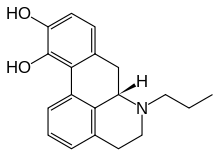Propylnorapomorphine
 | |
| Clinical data | |
|---|---|
| Routes of administration | Oral |
| ATC code |
|
| Legal status | |
| Legal status |
|
| Identifiers | |
| |
| CAS Number | |
| PubChem CID | |
| ChemSpider | |
| Chemical and physical data | |
| Formula | C19H21NO2 |
| Molar mass | 295.38 g/mol |
| 3D model (JSmol) | |
| Density | 1.2 g/cm3 |
| Boiling point | 446 to 536 °C (835 to 997 °F) [1] |
| |
N-n-Propylnorapomorphine (NPA) is an aporphine derivative dopamine agonist closely related to apomorphine.[2][3] In rodents it has been shown to produce hyperactivity, stereotypy, hypothermia, antinociception, and penile erection, among other effects.[4][5][6][7] Notably, its effects on locomotion are biphasic, with low doses producing inhibition and catalepsy and high doses resulting in enhancement of activity.[8] This is likely due to preferential activation of D2/D3 autoreceptors versus postsynaptic receptors,[9] the latter of which overcomes the former to increase postsynaptic dopaminergic signaling only with high doses.
See also
References
- ↑ "(6aS)-6-Propyl-5,6,6a,7-tetrahydro-4H-dibenzo[de,g]quinoline-10,11-diol". ChemSpider. Retrieved 16 January 2016.
- ↑ Miller RJ, Kelly PH, Neumeyer JL (January 1976). "Aporphines. 15. Action of aporphine alkaloids on dopaminergic mechanisms in rat brain". European Journal of Pharmacology. 35 (1): 77–83. doi:10.1016/0014-2999(76)90302-2. PMID 943290.
- ↑ Creese I, Padgett L, Fazzini E, Lopez F (July 1979). "3H-N-n-propylnorapomorphine: a novel agonist ligand for central dopamine receptors". European Journal of Pharmacology. 56 (4): 411–2. doi:10.1016/0014-2999(79)90274-7. PMID 477735.
- ↑ Menon MK, Clark WG, Neumeyer JL (November 1978). "Comparison of the dopaminergic effects of apomorphine and (−)-N-n-propylnorapomorphine". European Journal of Pharmacology. 52 (1): 1–9. doi:10.1016/0014-2999(78)90015-8. PMID 569056.
- ↑ Riffee WH, Wilcox RE, Smith RV (March 1979). "Stereotypic and hypothermic effects of apomorphine and N-n-propylnorapomorphine in mice". European Journal of Pharmacology. 54 (3): 273–7. doi:10.1016/0014-2999(79)90086-4. PMID 570924.
- ↑ Neumeyer JL, Reinhard JF, Dafeldecker WP, et al. (January 1976). "Aporphines. 14 Dopaminergic and antinociceptive activity of aporphine derivatives. Synthesis of 10-hydroxyaporphines and 10-hydroxy-N-n-propylnoraporphine". Journal of Medicinal Chemistry. 19 (1): 25–9. doi:10.1021/jm00223a006. PMID 942751.
- ↑ Benassi-Benelli A, Ferrari F, Quarantotti BP (December 1979). "Penile erection induced by apomorphine and N-n-propyl-norapomorphine in rats". Archives Internationales de Pharmacodynamie et de Thérapie. 242 (2): 241–7. PMID 44457.
- ↑ Campbell A, Baldessarini RJ, Ram VJ, Neumeyer JL (October 1982). "Behavioral effects of (-)10,11-methylenedioxy-N-n-propylnoraporphine, an orally effective long-acting agent active at central dopamine receptors, and analogous aporphines". Neuropharmacology. 21 (10): 953–61. doi:10.1016/0028-3908(82)90106-X. PMID 6890636.
- ↑ Argiolas A, Mereu G, Serra G, Melis MR, Fadda F, Gessa GL (January 1982). "N-n-propyl-norapomorphine: an extremely potent stimulant of dopamine autoreceptors". Brain Research. 231 (1): 109–16. doi:10.1016/0006-8993(82)90011-7. PMID 6799148.
This article is issued from
Wikipedia.
The text is licensed under Creative Commons - Attribution - Sharealike.
Additional terms may apply for the media files.